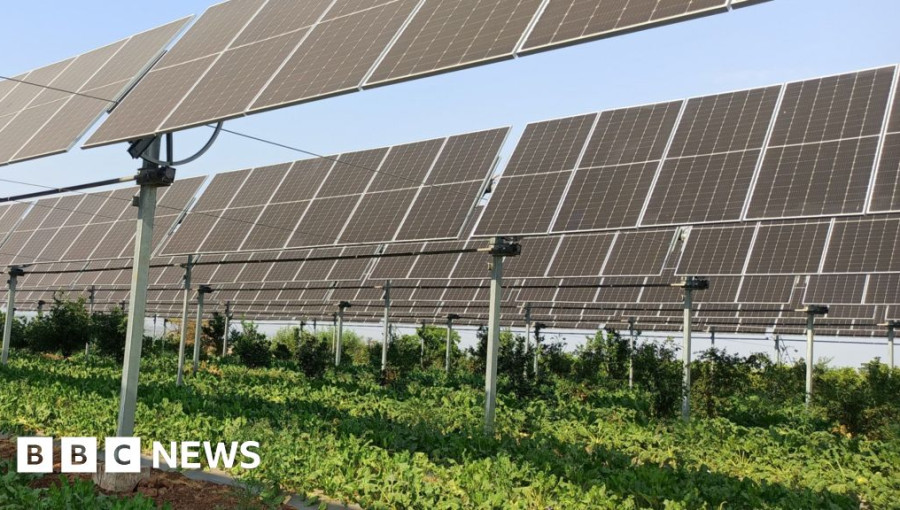Farming beneath solar panels, known as agrivoltaics, offers potential benefits to farmers seeking to mitigate the uncertainties of weather and climate change. Harpal Dagar, a farmer in Delhi, shares his positive experience after partnering with Sun Master to install solar panels above his fields. This innovative approach not only ensures a stable income through annual payments but also allows him to cultivate crops beneath the panels, resulting in a tripled income. Despite its advantages, the adoption of agrivoltaics in India faces challenges such as cost, crop compatibility, and regulatory concerns.
Siting solar panels above crops goes by the term agrivoltaics. India would seem particularly suited to such innovation. The fortunes of many of its farmers often hinge on an unpredictable monsoon, so a reliable income from a solar energy firm might provide some welcome financial security. But despite the benefits, take up has been slow, around 40 projects are operating in India at the moment, according to the National Solar Energy Federation of India (NSEFI), which represents India’s solar power industry. There are several challenges. Not all crops will grow under solar panels. Depending on the layout, the panels reduce the light getting through by between 15% and 30%. Some denser layouts will block too much sun for staple crops including wheat, rice, soybeans, or pulses.
“What works well are high-value crops with moderate or low-light needs, like green leafy vegetables, spices such as turmeric and ginger, and some flowers,” says Vivek Saraf, the founder and CEO of Delhi-based SunSeed, which specializes in agrivoltaics. There’s also the issue of expense. To allow farming underneath, the solar panels need to be at least 11ft (3.5m) off the ground. That makes them between 20% and 30% more expensive to install than panels on a regular solar farm, where they are much closer to the ground. “Small farmers cannot own these systems. They don’t have the risk appetite or capital,” says Mr. Saraf.
The solar power companies want the government to step in with subsidies to make agrivoltaics more attractive. “In India, where more than 55% of the population depends on agriculture and cultivable land is under mounting pressure, agrivoltaics offers a transformative model,” says Subrahmanyam Pulipaka, CEO of NSEFI. “It reduces irrigation needs, shields crops from heat stress, and stabilizes incomes by diversifying revenue streams for farmers. For rain-fed and climate-vulnerable regions, agrivoltaics can play a vital role in climate adaptation, making agriculture more resilient to unpredictable weather patterns,” he says.
SunSeed gives the farmer multiple options, including continuing to farm for a fixed salary or handing over all the farming responsibility to SunSeed. “Our model ensures the farmer is not exposed to any risk. If the crop fails or there’s a market issue, the loss is ours – not the farmers’,” he says. Meanwhile, SunSeed has been finely tuning its system to work with different crops and conditions. “We have developed sophisticated agrivoltaics simulation software,” he says. “It digitally replicates panel configurations and crop types to simulate how much light and heat each leaf receives, how photosynthesis is affected, and ultimately how much yield to expect.”
There’s still caution in government circles over the combination of solar power and farming. “Agrivoltaics is promising, but we must protect both the farmer and the developer,” says Manu Srivastava, who oversees solar and agrivoltaic projects in the state of Madhya Pradesh. “The biggest challenge is contracts. A 25-year lease needs clear obligations and protection for both sides. In India, long-term contract enforcement is still a hurdle,” says Mr. Srivastava. He also points out that agrivoltaics systems are more expensive than a traditional ground-mounted solar farm, so making a return on the

